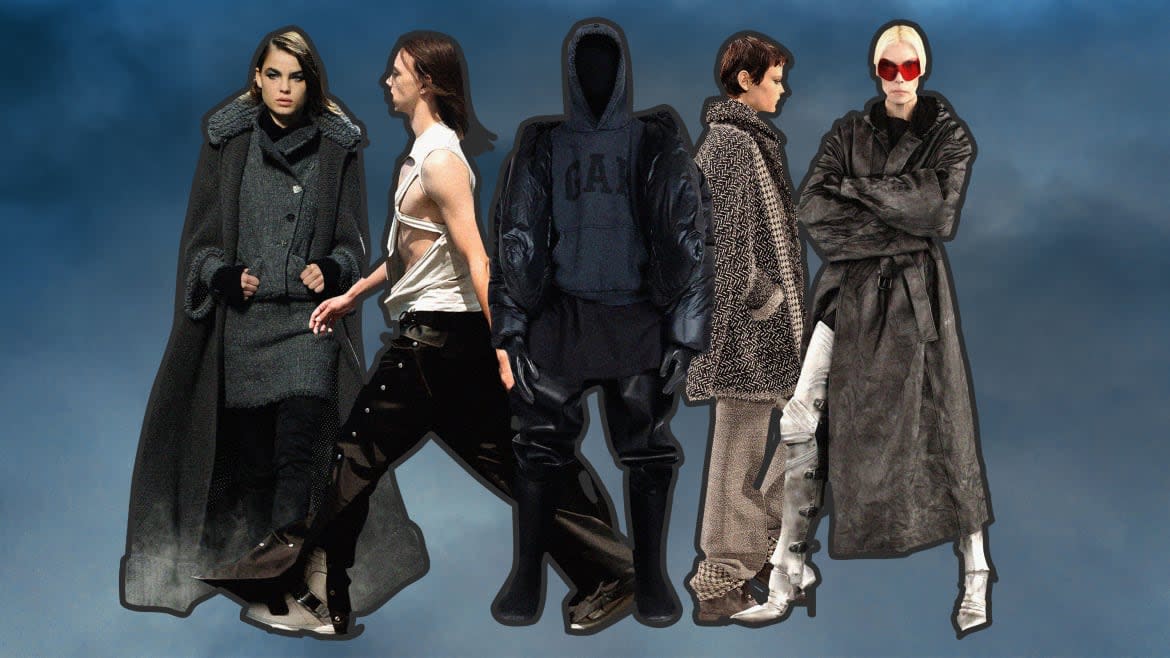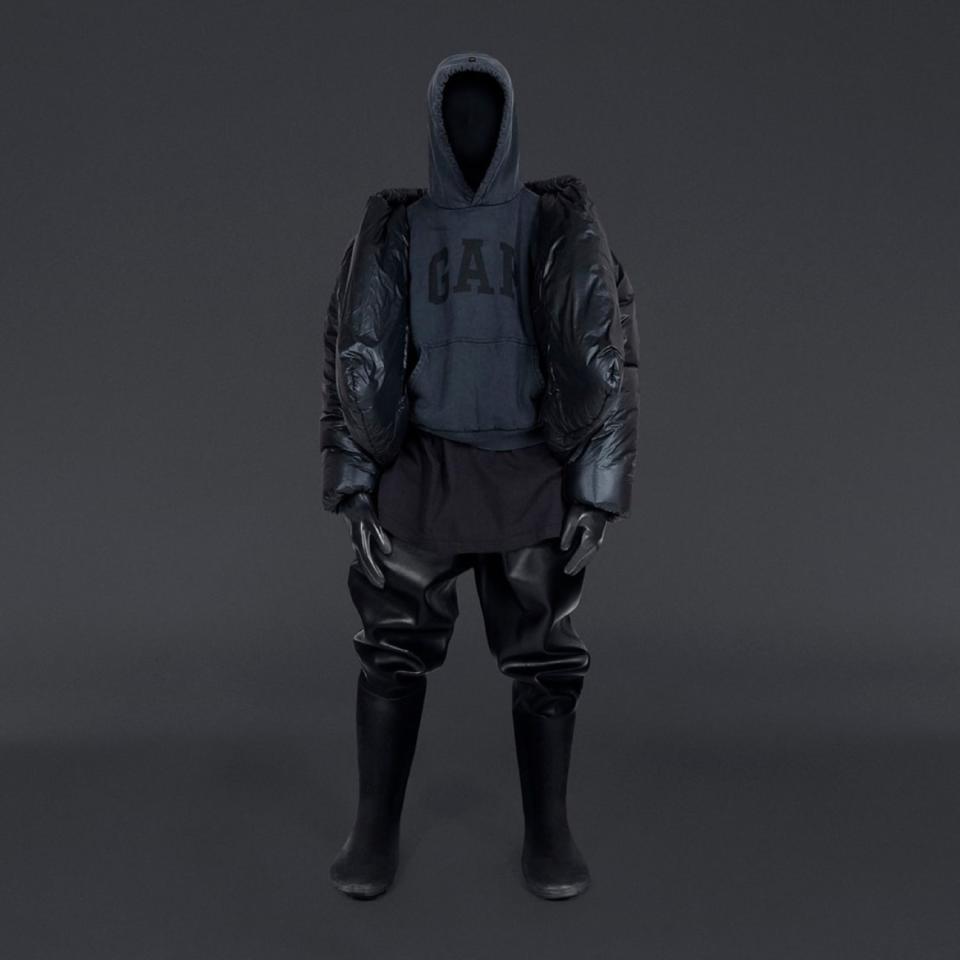How Kanye, Gap, and Chanel Are Dressing Us Down for Dystopia

If the world feels terrible right now, one can take small comfort in the cultural history of dystopia being a long one. From George Orwell’s 1984 to cinema franchises like Mad Max, fiction has interrogated what it would be like if we ever hit that point of dystopia or a borderline to present apocalypse. This idea of “the end of life as we know it” has long influenced the cultural zeitgeist, including fashion.
One example is the recent drop of Kanye West’s Yeezy Gap Engineered by Balenciaga collection. Business of Fashion credited Yeezy Gap Engineered by Balenciaga with bringing a dystopian retail experience to stores. Rather than the traditional well-merchandised, well-sized, particularly laid out approach to visual merchandising Gap takes, the Yeezy collection was available… in trash bags.
Did this deter many customers from shopping? Not at all. Shoppers waited hours in line to shop to purchase T-shirts and hoodies, many of which are now sold out in most sizes. The shopping area for the collection consisted of limited space with black floors and black walls, and customers recreating the scene of dumpster diving. It was dystopia at its most capitalist.
Despite the Yeezy Gap Engineered by Balenciaga collection nearly selling out, some aren’t as happy with this dystopian concept as one might think. Mike Grillo, a customer who recently shopped at Gap after the Yeezy Gap Engineered by Balenciaga launch, said, “We need to stop pretending Yeezy Gap is a thing. It’s literally trash bags full of black hoodies flopped in the center of your average gap [products.] Spare us. I also overheard a sales associate saying Yeezy Gap is the same materials Balenciaga uses, and I bet you my retirement fund it’s not.”
In an e-mail to The Daily Beast, Gap said that Yeezy Gap and Balenciaga, “are bringing their shared vision of physical retail to select Gap locations across the United States.” Gap did not respond for further comment regarding the visual merchandising of their physical retail stores for their collaboration with Balenciaga.

From Balenciaga Fall 2021 Ready-to-Wear Collection.

From Balenciaga Fall 2021 Ready-to-Wear Collection.
“There’s a lot of political upheaval, people are feeling economic insecurity, they are seeing industrial decay, and we have anxiety and fear over the COVID-19 virus,” said Shawn Grain Carter, professor of fashion business management at FIT and a luxury brand consultant. “Between all that, climate change, and WHO just declaring monkeypox a global health emergency. The masses feel like they can’t trust traditional institutions, no matter what nation-state they are in. We have mass shootings; the January 6 insurrection was the end of smooth transitions of power. People feel they are in a dystopian world.”
Grain Carter added, “Social media has added to our anxiety. Once upon a time, we wouldn’t have been seeing China in lockdown during COVID-19 with security guards at their doors to the extent we would before social media. Social media is how many of us consume our news now. The masses feel the covenant has been broken, and fashion is reflecting that.”
Grain Carter broke down the three sub-dystopian trends she’s seen as follows: pandemic cyberpunk, pandemic apocalyptic dressing, and pandemic goth revival. “Contemporary brands like Siskatank, Acronym, and Hexagon are all capitalizing on the dystopian aesthetic. At the same time, you have luxury brands like Balenciaga, Rick Owens, and Khaite blending these dark colors and playing cyberpunk with surrealism. Combine that with the pandemic fear that’s happening, there’s this sense of dread, and that’s what this dystopian fashion look is demonstrating.” (Siskatank, Acronym, and Hexagon did not respond to The Daily Beast’s request for comment.)
Balenciaga is no stranger to the idea of dystopian fashion either. The brand’s fall 2021 collection was proudly dystopian-themed, and even debuted in the Afterworld: The Age of Tomorrow video game.
Fashion critics described the collection as eerie, dystopian, and futuristic and was creative director Demna Gvasalia’s ideation of how we would dress high fashion in a pseudo-apocalyptic world ranging from head-to-toe Matrix-style black to asymmetric trench coats. Clothing is our armor, and we all can’t dawn military gear, and these aren’t the days of dressing like gladiators. (Balenciaga didn’t respond for further comment on their 2021 dystopian collection.)
Prior to Balenciaga’s 2021 show, fashion designer Rick Owens’ spring/summer 2019 menswear show was a dystopian fantasy. The Palais de Tokyo was the stage for the show, which featured multicolored smoke billowing from the towers above the fountain. It was a scene fitting for a post-apocalyptic world. The clothes included chopped-up muscle shirts, chaps, patchwork pants, and safari jackets. It was Owens’ take on what would happen if a dystopian dandy went hunting, and it was done with aplomb. (Rick Owens did not immediately respond to The Daily Beast’s request for comment.)

A model walks the runway during the Rick Owens Menswear Spring/Summer 2019 show as part of Paris Fashion Week on June 21, 2018.

A model walks the runway during the Rick Owens Menswear Spring/Summer 2019 show as part of Paris Fashion Week on June 21, 2018.
One of the most famous dystopian-themed collections was Karl Lagerfeld’s fall 2011 collection for Chanel titled “apocalypse wow.” The show was in the usual vein of Lagerfeld’s larger-than-life runway productions for Chanel, with a set resembling a science fiction film. The deflection away from the usual beautiful pastel tweeds and expected luxury of the brand fascinated the fashion industry. Instead, punk-inspired trouser suits, wide jackets, and dark tweeds ruled this runway. Instead, punk-inspired trouser suits, wide jackets, and dark tweeds ruled this runway.

Models walk the runway during the Chanel Ready to Wear Autumn/Winter 2011/2012 show during Paris Fashion Week at Grand Palais on March 8, 2011.

A model walks the runway during the Chanel Ready to Wear Autumn/Winter 2011/2012 show, at Paris Fashion Week.
Of the present moment, fashion historian Jane Tynan said COVID and its after effects loomed large, adding, “The fashion industry has had to reflect on its part in the climate crisis so there is a sense of loss right now but also a suspicion that we are facing a period of profound change. Right now, everything is in question, and dystopian fashion is reflecting that sense of fear and crisis.”
Tynan’s latest book, Trench Coat: Object Lessons, discusses how after WWI, the trench coat became fashionable because instead of turning away from the dystopian landscape of the trenches of war, people sought out a garment reminiscent of the war as if they were still being embattled. The trench coats' popularity only grew after WWII.
Tynan also pointed out how fashion designer Coco Chanel brought black into the fashion lexicon and fashion designer Elsa Schiaparelli played with military styling. Schiaparelli created a coat in 1933 with bullet casing buttons, which resembled the trench coat. Later in 1938, her Skeleton dress was a dark, ghostly design that reflected the sense of crisis at the time - the Great Depression and the threat of another war might have inspired such dystopian fashion creations. Schiaparelli was also influenced by Surrealism, which allowed artful introspection and dark themes to enter fashion for the first time.

From Kanye West’s Yeezy Gap Engineered by Balenciaga collection.

From Kanye West’s Yeezy Gap Engineered by Balenciaga collection.
On Balenciaga and Rick Owen’s aesthetic, Tynan said, “[Balenciaga’s creative director], Demna Gvasalia’s, work has an anti-luxury approach, a kind of anti-fashion which for some might look dystopian. Lately, this has incorporated a tech aesthetic. More recently, Rick Owens goes for streetwear in colors and styles that might fit the dystopian label but has an upbeat quirkiness and absurdity.
“The more recent examples of dystopian fashion tend towards a kind of Mad Max feel, which might bring us back to the pandemic, the sense of hopelessness it’s brought, but also the realization that governments are unable to come up with answers to the most pressing questions of the age. Post-apocalyptic visions are an aesthetic response to government inaction on the climate crisis, racial injustice, and global economic inequality. Clothes are no refuge against the various threats we face, but they are a symbolic defense and when we feel insecure our bodies feel it keenly.”
Gap wasn’t the first to launch a dystopian-themed store. In 2021, Beijing-based beauty brand Harmay unveiled its new retail concept in downtown Beijing titled “chaos and disorder” based on themes of dystopia. The idea behind the visual merchandising of the store was a dugout apocalyptic spaceship and was a big change from Harmay’s past, more traditionally glamorous beauty stores.
The color scheme was black and white, and parts of it looked like an abandoned factory. Although retail is thought to be something to look pretty and inviting to get people to shop, this was the opposite of what you’d expect from a beauty brand especially. (Harmay did not respond to The Daily Beast’s request for comment.)
Maurice Carlos Ruffin, the author of the dystopian fiction novel We Cast a Shadow, said, “Writers who write dystopia are always looking at the present problems and extrapolating them into the present and future problems. People often miss the points of these books, but when society starts to fray and people feel stressed out, they come back to dystopian writers and novels. Dystopia is forever. Going back to the 1930s and looking at books like Black No More by George Schuyler, writers have always leaned into dystopian themes when they feel things in the world aren’t quite right.”
Ruffin added, “People feel like we are leaving in dystopia, so people are obsessed with trying to get perspective on it. Dystopia has more permanence in our cultural zeitgeist because in the past things were speculative, but now between all the technology we have, the consequences of technology we have, and us living in a world where we could potentially destroy ourselves with climate change, the obsession with dystopia will continue.”
Ruffin said the reason dystopia is seeping beyond just books, movies, and television shows, and into artistic mediums, like fashion, now is because “People have tired of how homogenized culture is and how much of it is created by corporate entities. Dystopian creativity has a certain authenticity to it, whether it’s some strange jacket with sharp cornered shoulders that glow in the dark, people want something unique that they can’t find on the shelf or rack of a megastore.”
Get the Daily Beast's biggest scoops and scandals delivered right to your inbox. Sign up now.
Stay informed and gain unlimited access to the Daily Beast's unmatched reporting. Subscribe now.

 Yahoo News
Yahoo News 
